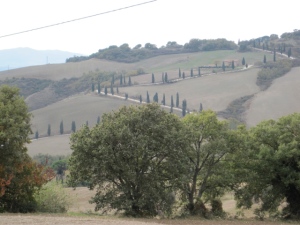The fleur-de-lis is a familiar symbol of all things French, from heraldry to Joan of Arc, so I was surprised to see the symbol in Siena, Italy as the fior di lisi. It’s the coat of arms for Florence, and so also appears in Siena, because Florence is the capital of Tuscany (our guide and friend Antonella is fiercely loyal to Siena, and so likes to downplay that last fact).
The Italian symbol appeared on coins minted in Florence in the 12th century – the same time it appeared on coins in France (thanks to this interesting site for the info: www.fleurdelis.com/fleur.htm). But look carefully at the two symbols and you’ll see that the Italian version shows stamen sticking out of the flower.
And what is that flower? It’s commonly known as a lily, but doesn’t look like any lily I’ve ever seen, unless someone has purposely bent back the petals to make it look like an iris. That is the alternate interpretation – that it’s an iris; now, which makes much more sense, because you can see the falls (petallike structures bending down) and a standard (petallike structure sticking up) so clearly. The fleur-de-lis, known as the golden lily, appears to be Iris pseudoacorus – the yellow flag of marshy ground and water’s edge in Europe.
Except for those stamen in the Italian version. Stamen don’t stick out of an iris; the bees need to land on the fall (which is fuzzy in bearded iris) and crawl in. Maybe the Italians just wanted to set themselves apart from the French, and so they added the floral structure to mark the Florentine fior di lisi. Regardless, it’s always good to see botany getting its due through the many centuries of heraldry and religious symbols.
Next summer, we’ll check out the French version on our tour of Normandy,
Brittany, and Paris, where we may indeed see a few real lilies and irises. Here are the details of the tour.




